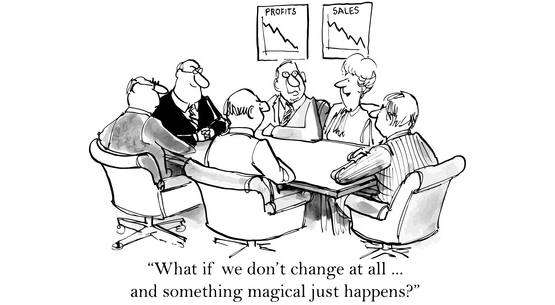Change is an inevitable part of life and business. If your business is not changing regularly, then it's unlikely to last beyond the short-term. All durable organizations have strategies and processes to deal with change so that they don't get left behind by the competition.
As we mention in our
Change Management course, it's very common for people in organizations to fear change. Humans are hard-wired to be risk-averse, and to prefer the status quo. However, change should be part and parcel of a business's daily operation. It should be the way the business works, and should sit at the heart of what the business stands for.

So how do you make change work in an organization? Let's have a look at the 8 best ways to deal with change.
1. Change regularly
Make your staff accustomed to change. Rather than waiting until absolutely necessary to make one big change, make change a process - a journey. Make it an exciting part of work, and alter the way change is perceived in the organization. Don't change for the sake of change, but make the business environment a place of continuous improvement and refinement.
2. Build a flexible workforce
Flexibility is the shock absorber that facilitates effective change management, and stops the process from breaking the company. Flexibility comes from the top. It involves strategic adaptability, and the company's capacity to train its staff.
Employees that are able to perform several job roles, and have the ability to adapt to different environments, are more likely to help an organization proceed through change. This flexibility comes from training, recruiting the right people and an organizational culture that supports everyone as individuals.
3. Build a great company culture
An organization can be defined by its workforce, and its collective attitude to change. If your workforce is able to adapt to different situations, willing to work until the job gets done, and able to deal with stress as it occurs in a newly evolving workplace environment, then your company is likely to be culturally ‘fit'.
Cultural fitness involves buffers to mitigate against employee stress, encourages personal responsibility in terms of job performance, training and interactions with employees and customers, and enables each member of the company to feel as though they are contributing towards its success.
4. Communicate honestly
Employees can sense when something is wrong. When an organization fails to communicate effectively with its staff, they will talk amongst themselves and it's quite possible for a culture of fear to emerge.
Communicate necessary changes to your teams frequently, honestly and openly – this way, you'll nip fear in the bud, and pull your teams closer together, even during turbulent times.
5. Prevent power hoarding
Change means uncertainty, and in uncertain environments people tend to try and hold on to their power and authority. This can often mean that people withhold information that should be shared, and cross-silo communication and co-operation can diminish.
During a change management process it is vital that you understand the pivotal people in the change process and that you manage them effectively. This means understanding their interactions with other people.
Do they have an open door policy, or are they secretively locked away in the office? Are they following honest and transparent policies that will ensure the change occurs effectively? Are they holding and attending enough cross-department meetings to facilitate a free flow of information?

Keep an eye on the key players during times of change, and make sure they don't become nodes of dysfunction in the organization.
6. Get people involved from the start
A change process works best when stakeholders are wholeheartedly engaged in the process. This means getting people involved from the start: get their input on how things should progress, and what the end result should be. By getting stakeholder feedback throughout the organization, and providing an inclusive platform for change, you will foster the right attitudes to change.
7. Show strong leadership skills
Perhaps the most crucial aspect of change in any organization is the leadership. There must be a hundred percent commitment to an action from the top for belief in the change to trickle down through the layers and silos.
Strong leadership is more than lip service to management ideas; it means direct, personal, and passionate communication from those at the top of the organization. It means the CEO, HR Director and every other pivot say the same thing: "This is what we are going to do; and it
is going to make the company better". Lack of strong leadership will mean a lack of direction.
8. Accept that change is inevitable
As the pace of technological advancement increases, and consumer behaviours become more sophisticated, organizational change, acquisitions, mergers and resizing will become more and more prevalent.
Agility is the key survival trait in 21st century business. It will be the organizations that can change direction in days or weeks, rather than months, that will lead the pack.
Sometimes change is imposed through a merger or other organizational event, but it is important to recognise that change is happening all the time – understand it and deal with it, and you'll set your company up for success.






















